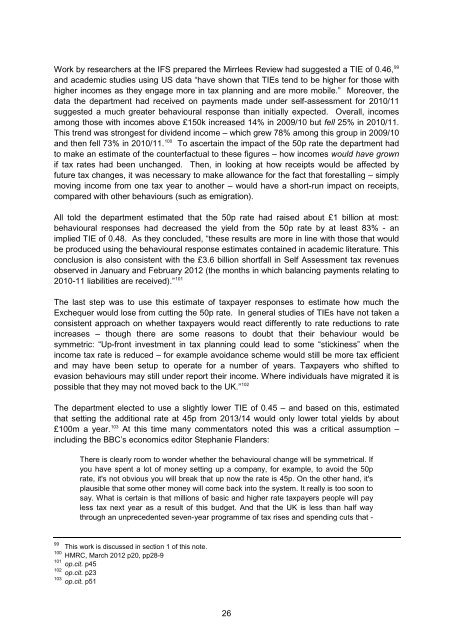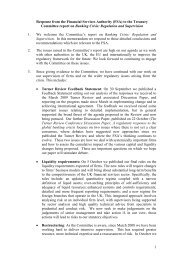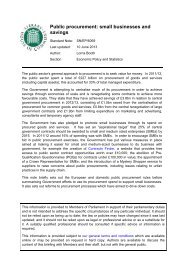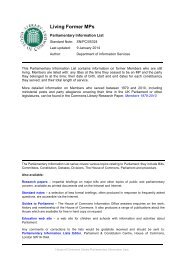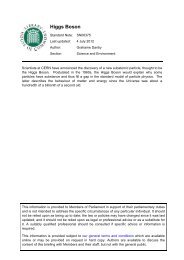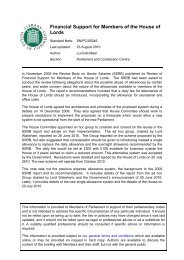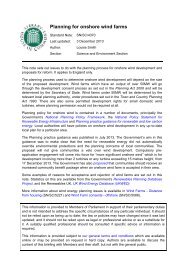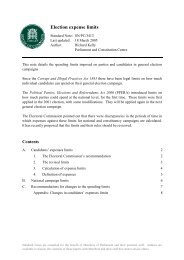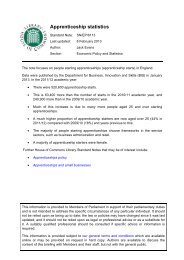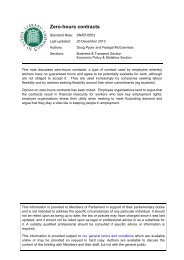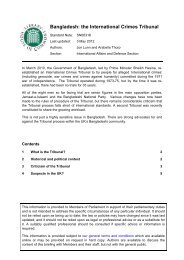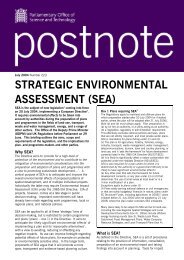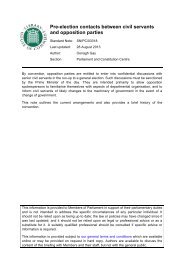Income tax: the additional 50p rate ( PDF, 41 pages ... - Parliament
Income tax: the additional 50p rate ( PDF, 41 pages ... - Parliament
Income tax: the additional 50p rate ( PDF, 41 pages ... - Parliament
You also want an ePaper? Increase the reach of your titles
YUMPU automatically turns print PDFs into web optimized ePapers that Google loves.
Work by researchers at <strong>the</strong> IFS prepared <strong>the</strong> Mirrlees Review had suggested a TIE of 0.46, 99<br />
and academic studies using US data “have shown that TIEs tend to be higher for those with<br />
higher incomes as <strong>the</strong>y engage more in <strong>tax</strong> planning and are more mobile.” Moreover, <strong>the</strong><br />
data <strong>the</strong> department had received on payments made under self-assessment for 2010/11<br />
suggested a much greater behavioural response than initially expected. Overall, incomes<br />
among those with incomes above £150k increased 14% in 2009/10 but fell 25% in 2010/11.<br />
This trend was strongest for dividend income – which grew 78% among this group in 2009/10<br />
and <strong>the</strong>n fell 73% in 2010/11. 100 To ascertain <strong>the</strong> impact of <strong>the</strong> <strong>50p</strong> <strong>rate</strong> <strong>the</strong> department had<br />
to make an estimate of <strong>the</strong> counterfactual to <strong>the</strong>se figures – how incomes would have grown<br />
if <strong>tax</strong> <strong>rate</strong>s had been unchanged. Then, in looking at how receipts would be affected by<br />
future <strong>tax</strong> changes, it was necessary to make allowance for <strong>the</strong> fact that forestalling – simply<br />
moving income from one <strong>tax</strong> year to ano<strong>the</strong>r – would have a short-run impact on receipts,<br />
compared with o<strong>the</strong>r behaviours (such as emigration).<br />
All told <strong>the</strong> department estimated that <strong>the</strong> <strong>50p</strong> <strong>rate</strong> had raised about £1 billion at most:<br />
behavioural responses had decreased <strong>the</strong> yield from <strong>the</strong> <strong>50p</strong> <strong>rate</strong> by at least 83% - an<br />
implied TIE of 0.48. As <strong>the</strong>y concluded, “<strong>the</strong>se results are more in line with those that would<br />
be produced using <strong>the</strong> behavioural response estimates contained in academic literature. This<br />
conclusion is also consistent with <strong>the</strong> £3.6 billion shortfall in Self Assessment <strong>tax</strong> revenues<br />
observed in January and February 2012 (<strong>the</strong> months in which balancing payments relating to<br />
2010-11 liabilities are received).” 101<br />
The last step was to use this estimate of <strong>tax</strong>payer responses to estimate how much <strong>the</strong><br />
Exchequer would lose from cutting <strong>the</strong> <strong>50p</strong> <strong>rate</strong>. In general studies of TIEs have not taken a<br />
consistent approach on whe<strong>the</strong>r <strong>tax</strong>payers would react differently to <strong>rate</strong> reductions to <strong>rate</strong><br />
increases – though <strong>the</strong>re are some reasons to doubt that <strong>the</strong>ir behaviour would be<br />
symmetric: “Up-front investment in <strong>tax</strong> planning could lead to some “stickiness” when <strong>the</strong><br />
income <strong>tax</strong> <strong>rate</strong> is reduced – for example avoidance scheme would still be more <strong>tax</strong> efficient<br />
and may have been setup to ope<strong>rate</strong> for a number of years. Taxpayers who shifted to<br />
evasion behaviours may still under report <strong>the</strong>ir income. Where individuals have mig<strong>rate</strong>d it is<br />
possible that <strong>the</strong>y may not moved back to <strong>the</strong> UK.” 102<br />
The department elected to use a slightly lower TIE of 0.45 – and based on this, estimated<br />
that setting <strong>the</strong> <strong>additional</strong> <strong>rate</strong> at 45p from 2013/14 would only lower total yields by about<br />
£100m a year. 103 At this time many commentators noted this was a critical assumption –<br />
including <strong>the</strong> BBC’s economics editor Stephanie Flanders:<br />
There is clearly room to wonder whe<strong>the</strong>r <strong>the</strong> behavioural change will be symmetrical. If<br />
you have spent a lot of money setting up a company, for example, to avoid <strong>the</strong> <strong>50p</strong><br />
<strong>rate</strong>, it's not obvious you will break that up now <strong>the</strong> <strong>rate</strong> is 45p. On <strong>the</strong> o<strong>the</strong>r hand, it's<br />
plausible that some o<strong>the</strong>r money will come back into <strong>the</strong> system. It really is too soon to<br />
say. What is certain is that millions of basic and higher <strong>rate</strong> <strong>tax</strong>payers people will pay<br />
less <strong>tax</strong> next year as a result of this budget. And that <strong>the</strong> UK is less than half way<br />
through an unprecedented seven-year programme of <strong>tax</strong> rises and spending cuts that -<br />
99<br />
This work is discussed in section 1 of this note.<br />
100 HMRC, March 2012 p20, pp28-9<br />
101 op.cit. p45<br />
102 op.cit. p23<br />
103 op.cit. p51<br />
26


